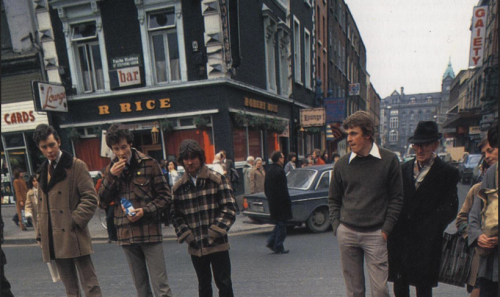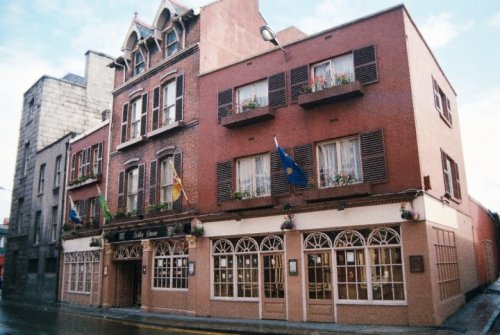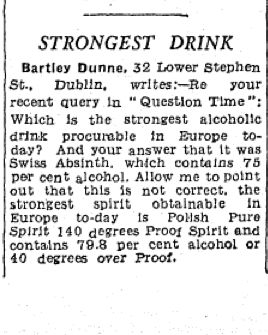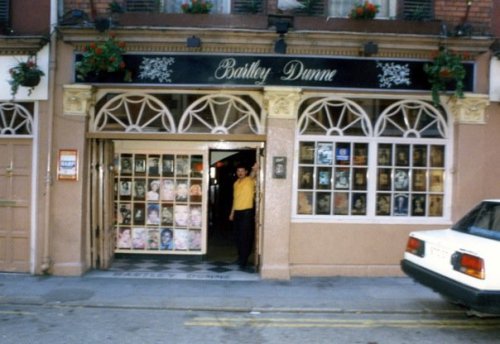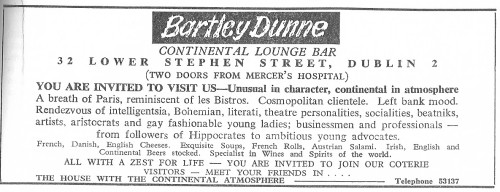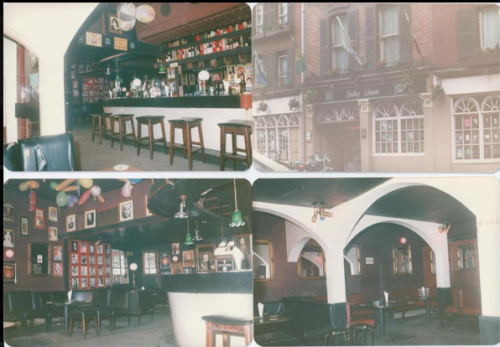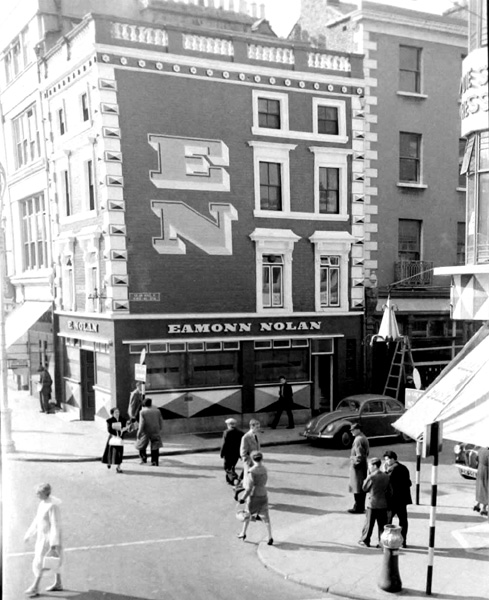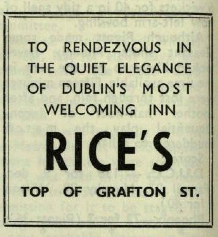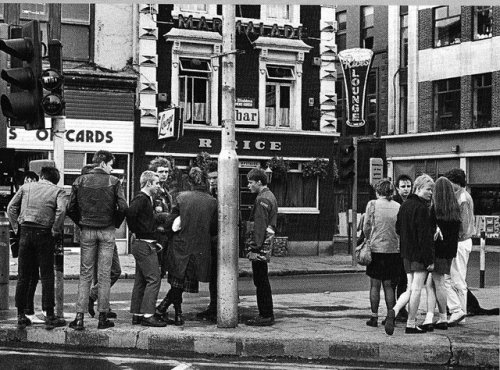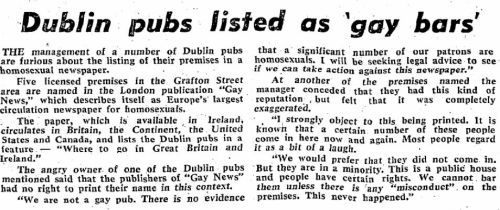Introduction
As for most of us, being gay in those days was a very lonely experience. There weren’t many opportunities to meet gay people, unless you knew of the one bar – two bars, actually, in Dublin at that time, Bartley Dunne’s and Rice’s … They were the two pubs and if you hadn’t met gay people, you wouldn’t have known about these pubs; there was no advertising in those days, and it was all through word-of mouth.
So the life of a gay man in Dublin in the early 1970s was summed up by one contributor to Coming out: Irish gay experiences (2003). Rice’s and Bartley Dunne’s first emerged as gay-friendly pubs in the early 1960s. Some believe that it might have been as early as the late 1950s and I would love to be able to prove this if anyone has any supportive evidence.
There are no traces left of either establishment. Rice’s, at the corner of Stephen’s Green and South King Street, was demolished in 1986 to make way for the Stephen’s Green Shopping Centre. While Bartley Dunne’s, on Stephen’s Street Lower beside the Mercer Hospital, was torn down in 1990 and replaced with ‘Break for the Border’.
On a side note, some people may be surprised to hear that gay taverns in England date back to the 1720s (Molly houses) while more ‘modern’ establishments like Café ‘t Mandje in Amsterdam have been open since 1927.
Many in both the gay and straight community have described Rice’s and Bartley Dunne’s as deserving the title of being the city’s first gay friendly pubs. Why these two particular pubs though?
Most people point to the fact that both were in close proximity to the Gaiety Theatre and St. Stephen’s Green which at the time was a popular gay cruising area. It should also be acknowledged that the publicans from both establishments would have had to have been more progressive/accommodating in their views than the vast majority of other establishments in the city.
George Fullerton, who emigrated to London in 1968, was quoted in Dermot Ferritier’s 2009 book Occasions of Sin: Sex and Society in Modern Ireland as saying that:
In 1960s Dublin the [gay] scene basically consisted of 2 pubs – Rice’s and Bartley Dunne’s. I never experienced discrimination as such, probably because we were largely invisible.
Paul Candon in Gay Community News (February 1996) labeled Bartley Dunne’s as ‘the first gay pub as we know it in the city’ and also referenced Rice’s. He said there was a total of five regular gay-friendly bars to choose from in the 1960s in the immediate Stephens Green/Grafton Street area. The other three being Kings (opposite the Gaiety) and The Bailey and Davy Byrnes, both on Duke Street.
Kevin Myers wrote in The Irish Times (18 May 1995) of his student days in UCD in the late 1960s and how he discovered that ‘Rice’s … (was) in part a gay bar … Bartley Dunne’s was another‘. Furthermore Bartley Dunne’s was described as ‘the most famous and oldest gay bar in Dublin’ by Victoria Freedman in The cities of David: the life of David Norris (1995).
One contributor to Coming out: Irish gay experiences (2003) talks about coming up to Dublin in the late 1970s from the country whenever he could and spending ‘vast amounts of time in Rice’s, Bartley Dunne’s and the Hirschfield Centre‘. Patrick Hennessy made a similar comment on an Irish Times article about the death of early LGBT campaigner in Christopher Robson in March of this year:
Yes farewell to one who fought the good fight back in the days when young and not so young men would come round to the Hirschfeld Centre nervously asking for info. Or sitting in circles exchanging their first tentative views in public about being gay. And then a few weeks later you might see one or two of them sipping a drink in a corner of Bartley Dunne’s or Bobby Rice’s.
It’s hard to corroborate (as only snippets are available on Google Books) but it looks like the 1958 ‘Fielding’s Travel Guide to Europe’ described ‘the historic Bailey, entirely reconstructed’ as being full of ‘hippie types and Gay Boys’. It goes onto say that like Davy Byrne’s, neither pub would be ‘recommended for the “straight” traveler’. Surely if true this language is very deliberate? Though I have a feeling this review may have come from a later edition and Google Books muddled things up.
Bartley Dunne’s on Stephens Street Lower.
In 1940, Hayden’s pub (‘a well known seven-day licensed premises‘) on Stephen’s Street Lower was put on the market after the owner James Bernard Hayden declared bankruptcy. In a related series of events, it was reported in the Irish Press (26 September 1940) that the Gardai had objected to renewing the pub’s licence on the grounds that the premises was not being conducted ‘in a peaceful and orderly manner’. It had only closed one day the previous year.
The licence was taken over in August 1941 by Bartholomew ‘Bartley’ Dunne. A native Irish speaker from the West of Ireland, Bartley Dunne Sr. returned to Dublin after nearly forty years of living and working in Manchester. Hugh Delargy M.P. wrote in the Irish Press (16 March 1946) that while in the city Bartley Sr. was:
prominent in the United Irish League, the Gaelic League and the old Sarsfield Terrace. (He knew) Dan Boyle, John Dulanty, who is now the High Commissioner in London; Sir Daniel McCabe, who became Lord Mayor of Manchester, and Tom Cassidy, a great patriot, whose son is now one of the senior aldermen in the city.
Bartley Sr. ran the pub until his death in 1960. It was then taken over by his two sons – Bartley Jr. (known as Barry) and Gerard (known as Gerry). They redecorated the place and built up its reputation for stocking exotic drinks from all over the world. Barry later recalled to The Irish Times (7 Sep ’85) that ‘there was a time when, if a customer wanted a particular drink and we didn’t have it in stock, he got something else for free’.
It would seem that Bartley Dunne’s (known to many as BD’s), which had already been attracting Dublin’s avant garde and theatre crowd, started to become gay-friendly (by word of mouth) in the early 1960s. David Norris has written about visiting the pub as a schoolboy in his late teens in circa 1961/62:
Towards the end of my schooldays I started to explore a little. I had a kindred spirit in school and we occasionally visited a city centre bar called Bartley Dunne’s which was a notorious haunt of the homosexual demi-monde. It was an Aladdin’s cave to me, its wicker-clad Chianti bottles stiff with dribbled candlewax, tea chests covered in red and white chequered cloths, heavy scarlet velvet drapes and an immense collection of multi-coloured liqueurs glinting away in their bottles.
The place was (full) of theatrical old queens, with the barmen clad in bum-freezer uniforms. While not being gay themselves, as far as I know, the Dunne brothers were quite theatrical in their own way. Barry would hand out little cards, bearing the legend ‘Bartley Dunne’s, reminiscent of a left bank bistro, haunt of aristocrats, poets and artists’. Whatever about that, Saturday night certainly resembled an amateur opera in full swing. There only ever seemed to be two records played over the sound system: ‘Non, Je Ne Regrette Rien’ by Edith Piaf, and Ray Charle’s ‘Take These Chains From My Heart’.
Brian Lacey in his excellent ‘Terrible Queer Creatures: A History of Homosexuality in Ireland’ (2008) noted that among the many characters that frequented the bar was the then virtually unknown Norman Scott, whose 1960s affair with Jeremy Thorpe (later to become leader of the British Liberal Party) forced him to resign from the party in 1976. Scott lived in a flat near Leinster Road while in Dublin. Ulick O’Connor mentioned in his diaries that Scott also had a long relationship with an unidentified person prominent in an Irish political party.
We take it for the granted the range of drinks available in Dublin bars today but Bartley Dunne’s was really a trial blazer. It offered saki, tequila and ouzo before any other place in the city. Mary Frances Kennedy writing in The Irish Times (15 July 1960) was amazed at the range of wines available in Bartley Dunne’s including Bull’s Blood of Eger (11s 6d a bottle); Balatoni Reisling (10s a bottle); Tokak Aszu (19s 6d a bottle) and Samos Muscatel (11 6d a bottle).
In January 1964, an escaped inmate from Parkhurst Prison on the Isle of Wight was found in Bartley Dunne’s two days after the jailbreak. William Joseph O’Brien (39), originally from Waterford, broke into the pub and stole cash and cigarettes amounting to £60. The Irish Times (18 January) noted that Barry heard a noise downstairs in the bar and managed to climb out of a window and down a drain pipe to notify the Gardai. O’Brien, with thirteen previous convictions, was sentenced to nine months imprisonment for the break in. He was already serving an eight year sentence.
It was noted in The Irish Times (22 March 1967) that Moscow journalist Lev Sedin, who has visited Dublin a number of times, had recently published a book on Ireland that dealt with politics and economics as well as more ‘frivolous subjects’. One of these was a lyrical poem about Bartley Dunne’s and his experience there of being consulted on the correct pronunciation of the Russian wines in stock. Sedin recommended the pub to anyone in Europe ‘who wished to imbibe true culture’.
A writer called Endymion in a 1968 Dublin guide book described Bartley Dunne’s as the city’s ‘most unusual pub’. It’s clientele was an ‘an odd mixture of bohemians and down-to-earth Dubliners (that) creates an atmosphere which would have interested James Joyce.’
It was described by Roy Bulson in ‘Irish Pubs Of Character’ (1969) as:
one of Dublin’s most unusual pubs with its Continental atmosphere. Well worth a visit to mix with a variety of characters. Ask for the wine list which is one of the most reasonably priced and extensive in Dublin.
Bartley Dunne’s had a ‘French bistro ambience’ with prints on the walls by Cezanne, Monet and Picasso as well as Partisan theatre posters and photographs of film stars. It was also famous for its dimly lit nooks and crannies. Elizabeth Taylor and Richard Burton drank there regularly in 1965 during the filming of the ‘The Spy Who Came in from the Cold’. As did other actors like Kim Novak, Laurence Harvery, Noel Howard as well as local characters like Brendan Behan (who seemingly drank in every pub in Dublin!).
The pub had a reputation for all sorts of madness. A massive bar fight took place sometime in the late 1980s after someone objected to a biker driving his motorbike into the pub and asking for a pint. On another note, my uncle John told me it was the first pub in Dublin that he ever saw someone shooting up heroin in the toilets. A friend Ado also has a story (as I’m sure many others have) of being served his first pint there while still in his school uniform!
Younger brother Gerry passed away in 1981. Barry continued to run the place up until 1985 when the family put the pub on the market. It was bought by three Irish businessmen based in the U.S.
From c. 1985 to its last days in 1990, the pub became the defacto HQ for Dublin’s goth, curehead and alternative metal scene. Drug-dealing also became more open and without the Dunne family behind the bar, things seemed to have got even more wilder.
The pub was sold in July 1990, for a record-breaking £1.7m. It was knocked down and replaced by a super-pub called ‘Break for the Border’ which is still there today.
Rice’s at the corner of Stephen’s Green and South King Street
While Bartley Dunne’s stood out as an alternative bar with an avant-garde clientele early on, Rice’s was an unassuming traditional Dublin boozer. There was a pub on this site from at least the 1850s until the middle of the 1980s. Formally called Eamon Nolans (late 1950s), The Four Provinces (mid 1950s) and The Grafton Bar (1940s), it was taken over by publican Robert ‘Bobby’ Rice in 1960.
I believe it became gay-friendly from this point onwards. The gay ‘area’ of the bar was confined to the section inside the Stephen’s Green entrance. Tony O’Connell, who started visiting the place in 1965, remembers that if owner ‘Bobby was on duty and a non-gay couple came into that bar he would usher them into the back lounge, lest they be contaminated’. So while Bartley Dunne’s was a mixed pub, the gay community were sectioned off in the front bar of Rice’s.
Ireland’s most famous and accepted gay couple Hilton Edwards and Micheál Mac Liammóir (founders of the Gate Theatre) drank in Rice’s as did another famous Irish stage actor, Patrick Bedford.
Bobby, who was married and had an adopted son, was known to be very camp. His brother Pat worked in the pub as a barman and was seemingly very liked by the gay community. The pub was also extremely popular with students from the nearby Royal College of Surgeons.
Former patrons Anthony Redmond and Frank Meier wrote to The Irish Times in January 1986 to lament the closing and the tearing down of the pub. They described as Rice’s as having:
great warmth, character and charm and there was nothing garish, brash or kitsch about its decor. If it was a quiet drink or serious conversation you wanted, with the cacophony of raucous music, Rice’s was the place to go to … In the summer Rice’s pub always looked truly beautiful with baskets of geraniums hanging over the windows outside. It was wonderful to drop in for a quiet drink after a peaceful few hours in Stephen’s Green. The staff was always pleasant, especially Billy whose wit and banter was greatly enjoyed by habitutes like myself.
The Rice family later went on to open The Village Cafe in Rathmines.
Conclusion
From all accounts, the heyday of Rice’s and Bartley Dunne’s was in the 1960s when they were the only shows in town so to speak. They provided a very important early social space for gay men in the capital. Street harassment from the police or drunk revelers was almost non existent during these years.
The 1970s saw the establishment of Ireland’s first gay rights organisations and discos. The Irish Gay Rights Movement (IGRM) was founded in 1974 and the first gay disco soon followed over a health food store called Green Acres in Great Strand Street with DJ Hugo Mac Manus. In 1979, the Hirschfeld Centre opened in Temple Bar as a gay community centre and began running a disco on the weekend called Flikkers (Dutch word for ‘Faggot’).
Mark, who was on the scene in the early 1980s, told me:
The community centre was the first full-time gay and lesbian venue in Ireland. It housed a meeting space, a youth group, a café, a small cinema and film club and it ran discos at the weekend where lesbian, gay, bisexual and transgendered (LGBT) people socialised. It really was amazing and as a lonely lost 18 year old, having this place as a free club where I felt I belonged was essential.
1979 was the same year that The Viking bar on Dame Street opened its doors. Tony O’Connell remembers that this was an important ‘stopping point on the “pilgrimage” between Rice’s and Dunne’s’. Other popular gay-friendly bars in the 1970s/early 1980s included The Pygmalion (now Hairy Lemon), The South William (now Metro Cafe), The Parliament Inn (now Turk’s Head), The Oak on Dame Street, The Foggy Dew on Dame Street and The Pembroke (now Matt the Thresher) on Pembroke Street. Women-only lesbian nights were held upstairs at the weekend in JJ Smyths on Aungier Street in the early 1980s. Davy Byrnes and The Bailey (Saturday mornings only) still remained popular.
Dublin’s oldest-running gay bar The George opened on South Great George’s Street in 1985 and so the next chapter of Dublin’s gay social life begins.
Though Rice’s and particularly Bartley Dunne’s did remain popular (as far as I can work out) with the gay community in the 1970s and 1980s. One blogger (‘eskerriada‘) described Bartley Dunne’s in the 1980s as having ‘a weird mix of rockers, punks, bikers, students and middle aged gay men’. Though it was widely known that the two places were gay-friendly, both owners rarely liked the attention.
In the above piece from 1975, one proprietor (later to revealed as Barry Dunne) said:
It is known that a certain number of these people come in every now and again. Most people regard it as a bit of a laugh … This is a public house and people have certain rights
Ten years later when the pub was being sold by the family, Barry hadn’t really changed his tune, telling journalist Frank MacDonald in The Irish Times (7 September 1985) that the pub did attract a ‘few who were that way inclined but it was really nothing like the rumours’.
You wonder whether Barry Dunne has today, twenty eight years later, come to terms with the fact that his pub attracted a large amount of gay people and that it played a very important part in the social history of the community. You’d also hope that what he said to newspaper journalists (in a time when same-sex sexual activity was still criminalised) differed from his real-life views.
While both pubs were extremely different places, some key dates overlapped. Bobby Rice took over Nolans in 1960, the same year that the Dunne brothers took over the pub from their Dad. The Dunne family sold their pub in 1985 while Rice’s was demolished the following year. (Though Bartley Dunne’s was open, under new management, until 1990).
Both pubs played an integral role in the development of Dublin’s gay social scene (and as a result probably gay politics) and should be remembered.
If you have any memories, anecdotes, pictures or any related information about Rice’s or Bartley Dunne’s - please leave a comment or get in contact via email.
(Thanks to Tony O’Connell, Mark Irish Pluto, Mark Jenkins, John Geraghty and others for helping with this piece)

